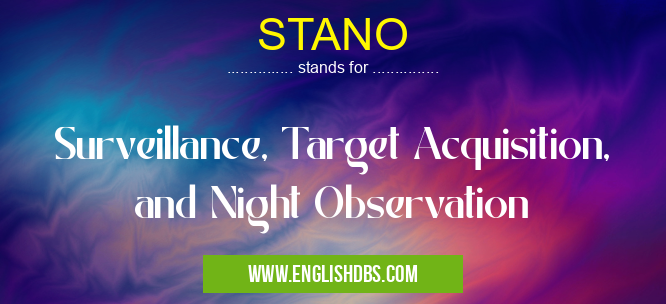What does STANO mean in MILITARY
Surveillance, Target Acquisition, and Night Observation (STANO) is an advanced collection of techniques and technologies used for detecting, tracking and observing targets in dark, unknown or otherwise inaccessible environments. This state-of-the-art system permits military personnel, law enforcement agencies and security personnel to monitor potential threats and perform accurate target recognition even in complete darkness.

STANO meaning in Military in Governmental
STANO mostly used in an acronym Military in Category Governmental that means Surveillance, Target Acquisition, and Night Observation
Shorthand: STANO,
Full Form: Surveillance, Target Acquisition, and Night Observation
For more information of "Surveillance, Target Acquisition, and Night Observation", see the section below.
» Governmental » Military
Surveillance
STANO involves the use of advanced sensors such as thermal imaging cameras that allow surveillance personnel to observe a wide area even when there is no visible light available. Thermal imaging cameras can detect heat signatures from potential targets at long distances, allowing operators to remotely determine their nature. Additionally, STANO can be augmented with radar systems to provide greater detection coverage at longer ranges.
Target Acquisition
STANO systems also enable precision target acquisition by providing operators with a wide range of advanced targeting algorithms that can help them identify their desired targets within an environment. These algorithms are capable of automatically analyzing large amounts of data from multiple sensor sources in order to pinpoint the location of specific objects or individuals. This allows for enhanced accuracy when attempting to acquire a particular target or eliminate unwanted targets from an area.
Night Observation
Night observation is arguably the most important element of STANO since this technology allows operators to detect targets in environments that would normally be impossible without visual aids such as night-vision goggles or other similar devices. By relying on thermal imaging cameras and other sophisticated sensors, STANO enables operators to monitor activity at any time regardless of weather conditions or time of day/night. In addition, this technology can also be used to detect potential adversaries who may be attempting to hide in difficult terrain or locations where they are less likely to be detected visually.
Essential Questions and Answers on Surveillance, Target Acquisition, and Night Observation in "GOVERNMENTAL»MILITARY"
What is STANO?
STANO stands for Surveillance, Target Acquisition, and Night Observation. It is the process of utilizing specialized visual tools to track, monitor and identify targets in day or night environments.
What are the components of STANO?
The components of STANO typically include telescopes, binoculars, scopes, night vision goggles/devices (NVGs) as well as thermal imaging cameras. These tools help assess the surrounding environment and discern target movement from that background.
What type of environment can I use STANO?
STANO is suitable for use in both day and night time environments such as open fields, urban areas, wooded areas or any other area with sufficient lighting or darkness.
How do I use STANO?
To correctly employ STANO techniques one must have a full understanding of the terrain being observed as well as the equipment being used. After familiarizing oneself with these two factors the observer should set up their equipment in a comfortable and stable position to optimize viewing capability. Once situated they can then begin tracking targets based on the varying levels of visible light and contrast between objects within their field of view.
What is night vision technology?
Night vision technology enables users to observe potential targets in low-light environments by amplifying available ambient light sources; allowing them to see otherwise invisible details within a given scene. This includes infrared light which is generally invisible to the naked eye but detectable by specialized NVGs.
How does thermal imaging work?
Thermal imaging differs from traditional nighttime optics in that it detects energy emitted from an object instead of reflected visible light; allowing observers to detect people and animals even if they are hiding behind foliage or other camouflaging features that would otherwise block out traditional night vision devices. Additionally, these devices don't require any additional illumination source such as moonlight or starlight to be effective - making them ideal for total darkness scenarios.
Are there limitations associated with STANO?
Yes — since most sighting systems rely on line-of-sight observation there may be obstructions blocking certain portions of an observer's field-of-view; limiting their ability to detect targets located beyond those obstructions. Additionally, certain vision obscuring phenomena such as fog and sandstorms can also impede visibility when attempting to observe potential targets at greater distances even when using more advanced NVGs/thermal imaging technologies.
What are some tips for successful target acquisition using STANO?
Tips for successful target acquisition include positioning yourself parallel to the ground level so that any movement stands out more vividly when compared to stationary elements within your field—of—view; minimizing movements while operating the surveillance devices; using scanning techniques such as zigzag motion across your field—of—view; keeping backlighting exposure minimized; and finally becoming familiar with typical silhouette shapes & sizes associated with various types of wild game/target species you may encounter in order not to miss them when surveying a given area.
Final Words:
In summary, STANO is an innovative suite of technologies designed for monitoring a wide variety of environments irrespective of visibility conditions or lighting levels. With its combination of sophisticated sensors and targeting algorithms, STANO enables personnel responsible for surveillance operations to remain well informed about potential threats at all times while ensuring accurate target recognition even in total darkness.
